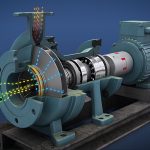The Future of Fire and Gas Detection Systems: Market Dynamics, Technological Innovations, and Growth Opportunities
The fire and gas detection system market is experiencing unprecedented transformation, driven by technological innovation and increasing safety regulations across industries. The market was valued at USD 15.56 Billion in 2024 and is projected to reach USD 39.80 Billion by 2033, representing a robust compound annual growth rate (CAGR) of 11%. This growth trajectory reflects the critical importance of advanced safety systems in protecting human life, property, and environmental assets across diverse industrial sectors.
Artificial intelligence and IoT integration are revolutionizing traditional detection methods, with AI-driven systems significantly reducing false alarms that have historically plagued the industry. The adoption of cloud-based monitoring platforms enables real-time oversight and faster emergency response coordination. Meanwhile, the emergence of hybrid solutions combining AI, IoT, and robotics is transforming industrial safety by enabling predictive analytics and autonomous threat response.
The broader fire protection systems market demonstrates even more substantial growth potential, with projections indicating expansion from USD 17.27 billion in 2025 to USD 49 Billion by 2035. This dramatic growth underscores the increasing recognition of fire and gas detection systems as essential infrastructure investments across commercial, industrial, and residential applications.
Download Sample Report (Get Full Insights In PDF- 199+ Pages) at: https://www.vantagemarketresearch.com/fire-and-gas-detection-system-market-0328/request-sample
Fire and Gas Detection System Industry Overview
In an era where industrial operations are becoming increasingly complex and safety regulations more stringent, fire and gas detection systems serve as the first line of defense against catastrophic events. These sophisticated systems have evolved far beyond simple smoke detectors, incorporating advanced sensor technologies, machine learning algorithms, and integrated monitoring platforms that provide comprehensive threat assessment and response capabilities.
The imperative for advanced fire and gas detection has never been more critical. Industrial accidents involving fire and gas incidents can result in devastating consequences, including loss of life, environmental damage, and billions of dollars in property damage and business interruption. The 2019 Philadelphia Energy Solutions refinery explosion, which ultimately led to the facility’s closure, exemplifies the catastrophic potential of inadequate fire and gas detection systems in industrial environments.
Modern fire and gas detection systems address these challenges through multi-sensor detection capabilities, wireless connectivity, and real-time monitoring. These technological advances enable industries to monitor potentially dangerous areas with unprecedented precision, offering significantly faster response times during emergency situations. The integration of predictive analytics and environmental monitoring adds another layer of protection by identifying potential risks before they escalate into dangerous situations.
Read Full Research Report with TOC: https://www.vantagemarketresearch.com/industry-report/fire-and-gas-detection-system-market-0328
Market Value and Growth Forecast (2024–2035)
- The fire and gas detection system market shows significant growth potential, with valuations ranging from $15.56 billion in 2024 to projections of $49 billion by 2035, depending on market scope and methodology.
- Growth rates vary from 3.2% to 11.0% CAGR, reflecting different market segments and regional factors.
- The broader fire protection systems market demonstrates substantial expansion opportunities across multiple industry sectors.
Key Market Drivers
The robust growth in fire and gas detection systems is driven by several converging factors that are reshaping industrial safety requirements. Stringent safety regulations and compliance requirements serve as primary catalysts, with regulatory bodies worldwide implementing more comprehensive safety standards that mandate advanced detection capabilities.
The increasing focus on workplace safety and risk mitigation has become a strategic priority for organizations across industries. Companies are recognizing that proactive investment in advanced detection systems not only ensures regulatory compliance but also protects valuable assets and maintains operational continuity. The advancement in sensor technology has significantly improved the accuracy and efficiency of detection systems, with modern systems featuring multi-sensor detectors, wireless connectivity, and real-time monitoring capabilities.
Industrial expansion and modernization efforts, particularly in emerging markets, are creating substantial demand for new fire and gas detection installations. The expansion of hydrogen economy applications is driving demand for specialized multi-gas detectors, particularly in Europe, with an estimated +0.8% impact on CAGR forecasts. Similarly, rising offshore deepwater exploration and production activities require high-reliability gas monitoring systems, contributing an estimated +0.6% impact on growth rates.
Technological Transformation
- AI-driven fire detection systems are successfully reducing false alarms by analyzing real-time data and distinguishing between actual fire risks and harmless anomalies like steam, dust, or cooking smoke.
- Cloud-based fire monitoring platforms now serve as the core infrastructure for commercial fire safety, enabling real-time oversight and faster emergency response coordination.
- IoT integration and smart technology are revolutionizing detection capabilities through wireless communication, predictive analytics, and automated response systems.
Adoption of Advanced Sensor Technologies
The technological landscape of fire and gas detection is undergoing dramatic transformation through the adoption of advanced sensor technologies that deliver unprecedented accuracy and reliability. AI-driven fire detection systems are revolutionizing the industry by significantly reducing false alarms, a persistent challenge that has historically led to unnecessary evacuations, operational disruptions, and costly emergency service callouts.
These intelligent systems employ pattern recognition and environmental context analysis to distinguish between actual fire risks and harmless anomalies such as steam, dust, or cooking smoke. The sophistication of modern detection algorithms enables predictive analytics that anticipate fire outbreaks based on historical and environmental data patterns.
Environmental monitoring capabilities have become integral components of modern fire and gas detection systems. Contemporary monitoring platforms track heat build-up, gas leaks, humidity, and electrical surges to provide early warning of potential ignition sources before they develop into dangerous situations. Multi-sensor devices monitor environmental factors that can signal fire risk, enabling proactive intervention rather than reactive response.
Smart detection systems now incorporate environmental sensors capable of detecting changes in air quality, carbon monoxide levels, humidity, and volatile organic compounds (VOCs) that may precede fire events. These devices communicate wirelessly with centralized control systems, providing detailed diagnostics that can pinpoint the origin of risks and alert both building occupants and emergency services within seconds.
Integration with Industrial IoT and AI
The convergence of Industrial Internet of Things (IoT) and artificial intelligence technologies is creating unprecedented capabilities in fire and gas detection systems. IoT integration serves as the digital nervous system of modern hybrid fire and gas safety systems, connecting distributed sensors that continuously track variables such as temperature, gas concentrations, humidity, and air pressure.
Cloud-based fire monitoring platforms have emerged as the core infrastructure for commercial fire safety operations in 2025. These systems enable facilities managers and business owners to access alerts, system status, and historical logs from any device in real-time, supporting faster decision-making and improved coordination with monitoring teams and emergency services.
The integration of AI-driven algorithms enables predictive analytics that can anticipate fire outbreaks based on historical and environmental data. Commercial buildings equipped with smart fire suppression systems can analyze daily activity patterns and optimize sprinkler deployment or gas suppression in real-time, reducing water damage and response delays.
Wireless communication technologies and edge computing enable these systems to process data and generate alerts in real-time, even in remote or hard-to-reach areas. The seamless integration with building management and emergency systems ensures coordinated, rapid response across all safety layers.
Market Segmentation by Product Type
- Integrated monitoring systems are increasingly linking fire detection with CCTV, access control, intruder alarms, and environmental monitoring to create comprehensive safety ecosystems.
- Wireless and portable detection systems are gaining traction for temporary installations, mobile operations, and flexible monitoring requirements.
- Hybrid solutions combining AI, IoT, and robotics represent the future direction of industrial safety systems.
Fixed Fire and Gas Detection Systems
Fixed fire and gas detection systems represent the largest segment of the market, encompassing permanently installed detection networks that provide continuous monitoring of industrial facilities, commercial buildings, and critical infrastructure. These systems typically feature hardwired sensor networks, centralized control panels, and integrated alarm and suppression systems that form the backbone of facility safety infrastructure.
The fire detection systems segment is projected to showcase the largest growth during the forecast period, representing approximately 50-55% of the total fire protection systems market. These detection solutions include intelligent smoke detectors, heat sensors, flame detectors, gas detection systems, and advanced multi-sensor platforms that enable early fire detection and automated emergency response.
Modern fixed systems incorporate smart smoke detectors and multi-sensor detection platforms that provide comprehensive fire monitoring capabilities. The complexity of fire detection requirements continues to increase as buildings integrate sophisticated HVAC systems, renewable energy sources, and sensitive electronic equipment that require specialized detection capabilities.
Integrated monitoring systems are increasingly being linked with CCTV, access control, intruder alarms, and environmental monitoring to create comprehensive safety ecosystems. When fire alarms are triggered, CCTV cameras can immediately focus on affected areas to confirm the presence of smoke or flames, while access control systems automatically unlock exit routes.
Portable Fire and Gas Detection Devices
Portable fire and gas detection devices serve critical roles in temporary installations, mobile operations, and situations requiring flexible monitoring capabilities. These devices address the unique challenges faced by temporary construction sites, events, and mobile operations that may have unsecured perimeters and limited access to fixed infrastructure.
Mobile fire detection units connected to remote monitoring services provide essential protection for temporary offices, site cabins, and event structures. These portable systems can detect smoke, heat, or flame and immediately report to centralized monitoring centers, ensuring that temporary installations receive the same level of protection as permanent facilities.
The emergency eyewash station type contributed to the highest market share in the gas detection equipment market in 2024, highlighting the importance of portable and accessible safety equipment in industrial environments. Portable detection devices provide essential capabilities for maintenance operations, confined space entry, and emergency response situations where fixed systems may be inadequate or inaccessible.
The flexibility and scalability of portable systems make them particularly valuable for organizations with changing operational requirements or multi-site operations that require consistent safety standards across diverse locations.
Market Segmentation by End-Use Industry
- Environmental monitoring systems now track heat build-up, gas leaks, humidity, and electrical surges to provide early warning of potential ignition sources before they escalate into dangerous situations.
- Multi-sensor devices monitor environmental factors that can signal fire risk, enabling proactive intervention rather than reactive response.
- Smart suppression systems can be remotely monitored to ensure proper activation, pressure maintenance, and timely servicing.
Oil & Gas Sector
The oil and gas sector represents one of the most demanding applications for fire and gas detection systems, given the inherently hazardous nature of hydrocarbon processing and the potentially catastrophic consequences of incidents. Rising offshore deepwater exploration and production activities are driving increased demand for high-reliability gas monitoring systems, with this trend contributing an estimated +0.6% impact on CAGR forecasts in the near term.
Oil and gas facilities require comprehensive detection systems capable of monitoring multiple gas types simultaneously, including hydrocarbons, hydrogen sulfide, carbon monoxide, and oxygen depletion. The harsh environmental conditions typical of oil and gas operations, including extreme temperatures, corrosive atmospheres, and explosive hazard zones, demand detection systems with exceptional reliability and durability.
Hybrid fire and gas safety systems incorporating AI, IoT, and robotics are particularly valuable in oil and gas applications, where they enable predictive analytics to anticipate potential hazards before they develop and provide autonomous, instant actions without waiting for manual input. These capabilities are essential in environments where human access may be limited or dangerous.
The sector’s adoption of smart suppression systems that can be remotely monitored ensures proper activation, pressure maintenance, and timely servicing. These systems are particularly critical in high-risk environments such as processing plants, refineries, and offshore platforms where rapid response times can prevent minor incidents from escalating into major disasters.
Chemical and Petrochemical Industries
Chemical and petrochemical industries face complex fire and gas detection challenges due to the diverse range of hazardous materials processed and the potential for chemical interactions that can create unexpected risks. These industries require specialized multi-gas detection capabilities that can simultaneously monitor for various toxic, flammable, and asphyxiant gases.
The expansion of hydrogen economy applications is particularly relevant to the chemical industry, driving demand for specialized detection systems capable of monitoring hydrogen and related compounds. The surge in green ammonia projects is boosting demand for ammonia leak detection systems, reflecting the industry’s transition toward more sustainable chemical processes.
Environmental monitoring systems that track heat build-up, gas leaks, humidity, and electrical surges provide early warning of potential ignition sources before they escalate. This proactive approach is particularly valuable in chemical processing environments where complex reactions and high-value equipment require continuous protection.
The integration of AI and predictive risk analysis enables machine learning tools to identify vulnerabilities before incidents occur. This capability is especially important in chemical facilities where process upsets or equipment failures can quickly lead to dangerous situations requiring immediate intervention.
Industry Applications and Regional Growth
- The oil and gas sector remains the largest end-use segment, driven by inherently hazardous operations and stringent safety mandates.
- Asia Pacific region is expected to witness the highest growth, driven by rapid industrialization in countries like China and India.
- North America and Europe maintain substantial market share due to stringent safety standards and established industrial infrastructure.
Regulatory Landscape and Compliance
The United States maintains one of the most comprehensive regulatory frameworks for fire and gas detection systems, with multiple agencies establishing overlapping requirements that drive market demand. The North America region is estimated to witness significant growth during the forecast period, driven by stringent fire safety regulations, increasing commercial construction activities, and growing emphasis on building safety compliance.
The Occupational Safety and Health Administration (OSHA) establishes workplace safety requirements that mandate fire and gas detection systems in numerous industrial applications. The Environmental Protection Agency (EPA) implements regulations under the Clean Air Act and Risk Management Program that require comprehensive gas detection and emergency response capabilities for facilities handling hazardous substances.
State and local building codes increasingly require advanced fire detection systems in commercial construction projects, with many jurisdictions adopting updated International Building Code provisions that mandate smart fire alarm systems and IoT integration. The trend toward stricter fire codes is reshaping commercial construction across the country.
Code compliance requirements are driving adoption of integrated systems that combine fire detection with broader building safety infrastructure. These requirements create sustained demand for system upgrades and retrofits as facilities work to maintain compliance with evolving regulations.
Major Industry Applications in the U.S.
The United States market demonstrates strong demand across multiple industry sectors, with particular strength in oil and gas, chemical processing, manufacturing, and commercial construction applications. The U.S. leads the North American region with substantial investments in fire protection infrastructure and smart building technologies.
Mandatory IIoT-enabled safety upgrades similar to those implemented by China State Administration of Work Safety are beginning to influence U.S. industrial facilities, particularly in high-risk sectors. The accelerating adoption of battery energy storage systems with associated fire and gas code requirements is creating new market opportunities, particularly in renewable energy installations.
The transition to low-GWP refrigerants is driving demand for specialized refrigerant gas detection systems across commercial and industrial HVAC applications. This trend is particularly significant in the United States, where federal regulations are phasing out high-GWP refrigerants in favor of more environmentally friendly alternatives.
Industrial modernization efforts in manufacturing sectors are creating opportunities for comprehensive fire and gas detection system upgrades, with facilities seeking to integrate modern detection capabilities with existing process control and safety systems.
Competitive Landscape and Key Players
- Atronica Fire and Security
- Emerson Electric
- MSA
- Honeywell
- Schneider Electric
- ABB
- Spartan
- Rockwell Automation.
Major Manufacturers and Market Share
The fire and gas detection system market features a competitive landscape dominated by established industrial automation and safety companies with comprehensive product portfolios and global distribution networks. Key manufacturers include ABB, Honeywell International, Rockwell Automation, Schneider Electric, Yokogawa, Autronica, Emerson Process Management, Johnson Controls, MSA Safety, Siemens, and Tyco International.
Major fire protection system manufacturers such as Johnson Controls, Honeywell, Siemens, and Carrier have significantly expanded their detection system product portfolios to meet growing demand across residential, commercial, and industrial applications. These providers have collectively increased their smart detection system production capacity to address market growth and technological advancement requirements.
The integration of artificial intelligence and wireless communication technologies is enabling detection system manufacturers to provide comprehensive fire monitoring and automated response capabilities. This technological differentiation is becoming increasingly important as customers seek integrated solutions rather than standalone detection devices.
Market leaders are investing heavily in research and development to maintain competitive advantages in emerging technology areas such as AI-driven detection algorithms, IoT integration platforms, and predictive analytics capabilities. The ability to provide comprehensive system integration services and ongoing support is becoming a key differentiator in the market.
Recent Strategic Developments
The competitive landscape is characterized by ongoing strategic developments as manufacturers work to strengthen their market positions and expand their technological capabilities. Companies are pursuing acquisitions, partnerships, and joint ventures to enhance their product portfolios and geographic reach.
Investment in next-generation fire safety solutions designed for modern construction needs is driving product development efforts across the industry. Manufacturers are focusing on developing systems that can seamlessly integrate with smart building infrastructure and provide enhanced connectivity and data analytics capabilities.
The development of hybrid solutions combining AI, IoT, and robotics represents a significant strategic focus area for leading manufacturers. These integrated platforms require substantial research and development investments and often involve partnerships with technology companies specializing in artificial intelligence and robotics.
Strategic partnerships with system integrators and engineering firms are becoming increasingly important as customers seek turnkey solutions rather than individual components. The ability to provide comprehensive design, implementation, and support services is becoming a key competitive requirement.
Market Drivers and Challenges
- Stringent safety regulations and compliance requirements serve as primary growth catalysts across industries worldwide.
- High initial capital investment requirements and technical complexity remain significant barriers to adoption.
- Cybersecurity concernsassociated with connected detection systems represent emerging challenges that must be addressed.
Barriers to Adoption and Market Restraints
Despite strong growth prospects, the fire and gas detection system market faces several challenges that may constrain adoption rates and market expansion. High initial capital investment requirements represent a significant barrier, particularly for smaller organizations or facilities with limited capital budgets. Advanced detection systems with AI and IoT capabilities require substantial upfront investments that may be difficult to justify without clear regulatory requirements or demonstrated return on investment.
Technical complexity and integration challenges can create obstacles for organizations seeking to upgrade existing systems or implement new detection capabilities. The integration of smart detection systems with legacy building management systems, process control networks, and emergency response procedures requires specialized expertise that may not be readily available.
Cybersecurity concerns associated with connected detection systems represent an emerging challenge as facilities become increasingly concerned about the potential for cyber attacks on critical safety infrastructure. The integration of IoT devices and cloud-based monitoring platforms creates new attack vectors that must be carefully managed through comprehensive cybersecurity strategies.
Maintenance and lifecycle management requirements for advanced detection systems can create ongoing operational challenges, particularly in facilities with limited technical support capabilities. The complexity of modern detection systems requires specialized training and support that may not be readily available in all geographic markets.
Emerging Opportunities for Growth
The fire and gas detection system market presents numerous opportunities for growth driven by technological advancement, regulatory development, and changing industrial requirements. The expansion of hydrogen economy applications creates substantial opportunities for specialized detection system manufacturers, particularly in Europe where hydrogen infrastructure development is accelerating.
Green energy transition initiatives are creating new applications for fire and gas detection systems in renewable energy installations, battery storage facilities, and hydrogen production and distribution infrastructure. The accelerating adoption of battery energy storage systems with associated fire and gas code requirements represents a significant growth opportunity.
Industrial digitalization and Industry 4.0 initiatives are driving demand for integrated detection systems that can provide comprehensive data analytics and predictive maintenance capabilities. The ability to integrate detection systems with broader industrial IoT platforms creates opportunities for enhanced system capabilities and improved operational efficiency.
Emerging market expansion in developing countries with growing industrial sectors presents significant opportunities for detection system manufacturers willing to invest in local distribution and support capabilities. The increasing focus on industrial safety and regulatory compliance in these markets is driving demand for modern detection systems.
Scope of the Industry
The fire and gas detection system market stands at a transformative inflection point, driven by technological innovation, regulatory evolution, and increasing recognition of the critical importance of proactive safety systems. With market valuations projected to nearly double from USD 15.56 Billion in 2024 to USD 49 Billion by 2035, the industry demonstrates exceptional growth potential across multiple sectors and geographic regions.
The integration of artificial intelligence, IoT connectivity, and predictive analytics is fundamentally reshaping detection system capabilities, enabling proactive threat identification and automated response systems that surpass traditional reactive approaches. AI-driven systems are successfully reducing false alarms while cloud-based monitoring platforms provide real-time oversight and coordination capabilities that enhance emergency response effectiveness.
The emergence of hybrid solutions combining AI, IoT, and robotics represents the future direction of industrial safety systems, offering unprecedented capabilities for threat detection, risk assessment, and autonomous response. These technological advances are particularly valuable in high-risk industrial environments where rapid response times and accurate threat assessment are critical for preventing catastrophic incidents.
Market opportunities span diverse industry sectors, from traditional oil and gas applications to emerging hydrogen economy infrastructure and renewable energy installations. The expansion of hydrogen economy applications and accelerating adoption of battery energy storage systems create new market segments with specialized detection requirements and significant growth potential.
As organizations increasingly recognize fire and gas detection systems as essential infrastructure investments rather than regulatory compliance costs, the market outlook remains exceptionally positive. The convergence of technological capability, regulatory requirements, and safety awareness creates a compelling foundation for sustained market growth and continued innovation in fire and gas detection technologies.
Market Segmentation
Parameter
Details
Segment Covered
By Application
- Oil and Gas
- Chemical and Petrochemical
- Pharmaceutical
- Other
By End Use
- Fire and Smoke Detectors
- Logic Controls and Alarms
- Fire Dampers and Suppression Systems
- Other
By Region
- North America (U.S., Canada, Mexico)
- Europe (Germany, France, U.K., Italy, Spain, Nordic Countries, Benelux Union, Rest of Europe)
- Asia Pacific (China, Japan, India, New Zealand, Australia, South Korea, South-East Asia, Rest of Asia Pacific)
- Latin America (Brazil, Argentina, Rest of Latin America)
- Middle East & Africa
Companies Covered
- Atronica Fire and Security
- Emerson Electric
- MSA
- Honeywell
- Schneider Electric
- ABB
- Spartan
- Rockwell Automation.
Customization Scope
Enjoy complimentary report customization—equivalent to up to 8 analyst working days—with your purchase. Customizations may include additions or modifications to country, regional, or segment-level data.
Pricing and purchase options
Access flexible purchase options tailored to your specific research requirements. Explore purchase options
Frequently Asked Questions
What is the projected market size of fire and gas detection systems by 2035?
According to analysts at Vantage Market Research, The fire and gas detection system market is projected USD 15.54 Billion in 2024 with a CAGR of 11%. The broader gas detection equipment market is expected to reach USD 36.86 billion by 2032 The comprehensive fire protection systems market, which includes detection systems, is projected to reach USD 49 billion by 2035, demonstrating the substantial growth potential across all segments of the fire and gas detection ecosystem.
Which industries are driving the demand for fire and gas detection systems?
The primary demand drivers include the oil and gas sector, particularly with rising offshore deepwater exploration activities, and chemical and petrochemical industries responding to the expansion of hydrogen economy applications and green ammonia projects. Additional growth is coming from battery energy storage systems with new fire and gas code requirements and facilities transitioning to low-GWP refrigerants that require specialized detection capabilities.
How are technological advancements impacting the market?
Technological advancements are revolutionizing the market through AI-driven fire detection systems that significantly reduce false alarms, cloud-based monitoring platforms enabling real-time oversight, and hybrid solutions combining AI, IoT, and robotics for predictive analytics and autonomous response. Smart fire alarm systems and IoT integration are providing real-time data, early detection, and automated responses through intelligent sensors.
Who are the leading players in the U.S. fire and gas detection system market?
Major manufacturers include ABB, Honeywell International, Rockwell Automation, Schneider Electric, Yokogawa, Johnson Controls, MSA Safety, Siemens, and Tyco International. The North American region is experiencing significant growth driven by stringent fire safety regulations and increasing commercial construction activities, with the U.S. leading the region in investments in fire protection infrastructure and smart building technologies.
What are the main challenges facing market growth?
Key challenges include high initial capital investment requirements for advanced detection systems, technical complexity and integration challenges with existing infrastructure, cybersecurity concerns associated with connected IoT devices, and maintenance and lifecycle management requirements that demand specialized expertise. However, these challenges are being addressed through improved system design, enhanced cybersecurity protocols, and expanded technical support services.
![[Market Research Reports] – Research Google News Blog | VMR.Biz](https://www.vmr.biz/wp-content/uploads/2022/12/logo-removebg-preview.png)











